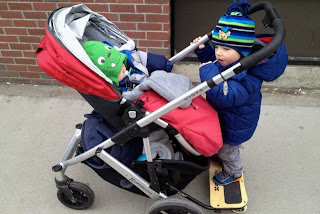My father-in-law had a hip operation, with replacement of the femoral head, last May. This intervention, almost routine, includes a long rehabilitation phase: Using crutches, recovery of muscle tone and adopting good postures when walking. This is not easy, because in addition to the intervention, we must add the habit of poor posture (caused by pain to move the leg before the surgery). After the hospital days, and a first rehabilitation period, the person returns home with crutches to manage, correct posture to regain and therapy exercises to do.
Yikes, Information Overload! So I thought that TAGteach could be of help.
Tag Point #1: Toe on the Line
The first detail on which we focused keeping toes pointed straight forward. Seemingly an easy task, but to complicate the picture you must add the use of crutches. We started focusing on a single movement. Standing still we use, as target, the lines on the floor: We practiced the behavior "toes forward" isolating it from the rest of the movements and standing still. In the video, the tag point is: "Toe upon the line"
Tag Point # 2: Paired
In this kind of surgery patients are, obviously, required to use crutches. To optimize the loading of weights, crutches and arms are made to move in an unnatural way: moving at the same time the arm and leg on the same side of the body. For example: the right arm and right leg move in unison. An unnatural movement to focus on, while at the same time remembering the toe that needs to go straight all while adjusting to the use of crutches.
In the second video we have adopted a slightly different version of the cousin tag point: our attention was still focused on posture (toe forward), but we wanted to put it in the context of walking with crutches. For this reason the "toe forward" was included in the Directions. To help the person we used as a target a line on the asphalt (you can clearly see it in the video). The tag point has focused on moving parallel arm and leg. Aware of the difficulties of this I asked the person to label this behavior (a personalized tag point), so it was easier for him to process the information, freeing up a little bit of cognitive resources for toe forward. The answer was: “appaiati” ("paired" in English).
The directions are: "toe upon the line".
The tag point is "paired".
Editor's Note: You may have noticed two things about these videos:
- The captions and the talking are in Italian, but it is easy for anyone of any language to understand what is going on. TAGteach translcends language barriers.
- The learner performed the task so easily that you might think, "What's the big deal?". In fact, TAGteach done well does look effortless and should. The skill of the teacher in breaking down the task, setting achievable tag points, starting from a point of success, creating a suitable environment and limiting the use of language to critical elements all work together to create the appearance of ease. Fantastico Luca!



.jpg)





